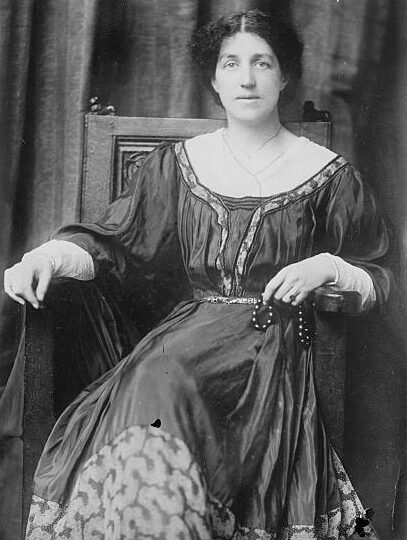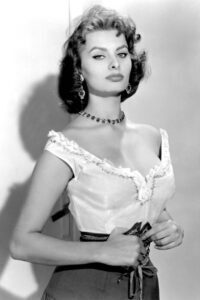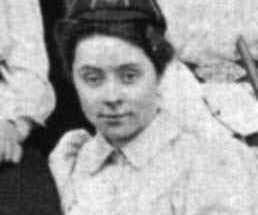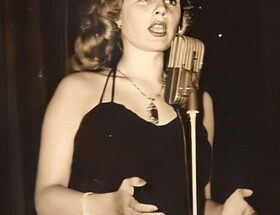Life & Death

May Morris was born on 25 March 1862 at Red House, Bexleyheath, the younger daughter of Pre-Raphaelite artist and designer William Morris and his wife and artist’s model Jane Morris (née Burden). She got the name Mary, as she was born on the Feast of the Annunciation. She had a
May learned to embroider from her mother and her aunt Bessie Burden, who had been taught by William Morris. In 1878, she enrolled at the National Art Training School, precursor of the Royal College of Art.
In 1885, aged 23, May became the Director of the Embroidery Department at her father’s enterprise Morris & Co. During her time in the role she was responsible for producing a range of designs, which were frequently misattributed as her father’s work. She ran this department until her father’s death in 1896, where she moved into an advisory role.
In 1886, May fell in love with Henry Halliday Sparling, secretary of the Socialist League. Despite her mother’s concerns about her future son-in-law, they married on 14 June 1890 at Fulham Register Office. The Sparlings divorced in 1898 and May resumed her maiden name.

May Morris by Dante Gabriel Rossetti (1872)
In 1907, May founded the Women’s Guild of Arts with Mary Elizabeth Turner, as the Art Workers Guild did not admit women. They were assisted in its foundation by Mary A. Sloane, Ethel Everett, Mabel Esplin and Letty Graham. The Women’s Guild of Arts became a leading association for women artists and craftswomen, providing networking and educational opportunities as an alternative to the Art Workers Guild.
May edited her father’s Collected Works in 24 volumes for Longmans, Green and Company, published from 1910 to 1915 and, after his death, commissioned two houses to be built in the style that he loved in the village of Kelmscott in the Cotswolds. Her companion at Kelmscott from 1917 until her death was Mary Lobb, a Land Army volunteer in the village.
After the death of her mother in early 1914, May took over responsibility for arranging the care of her epileptic sister, Jane Alice Morris.
May died at Kelmscott Manor on 17 October 1938.
Embroidery
May was an influential embroideress and designer, although her contributions are often overshadowed by those of her father, a towering figure in the Arts and Crafts movement. She continued his resurrection of free-form embroidery in the style which would be termed art needlework. Art needlework emphasized freehand stitching and delicate shading in silk thread thought to encourage self-expression in the needleworker in sharp contrast with the brightly coloured Berlin wool work needlepoint and its “paint by numbers” aesthetic which had gripped much of home embroidery in the mid-19th century.
May was also active in the Royal School of Art Needlework (now Royal School of Needlework), founded as a charity in 1872 under the patronage of Princess Helena to maintain and develop the art of needlework through structured apprenticeships. The school originally opened in the autumn of 1872 in rooms in Sloane Street, London, with a staff of twenty women overseen by Lady Welby and Mrs Dolby, an “authority in ecclesiastical work”.
While the course available in the government schools of design for women was theoretical only, the RSAN had the distinct advantage of a practical, hands-on technical training. The school grew rapidly, and by 1875 had moved into their third locale, conveniently located in Exhibition Road next to the South Kensington Museum. The collections of ancient embroidery in the Museum were studied in an effort to understand and relearn old work.
Also among the staff at the RSAN were May‘s maternal aunt, Elizabeth Burden, who was chief technical instructor from 1880 and designers Deborah Birnbaum (c1889) and Nellie Whichelo (c1890).
May taught embroidery at the LCC Central School of Art in London from 1897 and was head of the Embroidery department from 1899 until 1905, thereafter continuing her association with the Central School as Visitor until 1910. She also taught at Birmingham, Leicester and Hammersmith Art School.
By 1916, there were many art schools under the LCC umbrella that included embroidery in their curriculum. Among the embroidery instructors were sisters Ellen M Wright and Fanny I Wright, both previously employed in the Embroidery Department at Morris & Co., and trained by May. Ellen M Wright also taught at the Clapham School of Art, aided by Miss F Pooley, and Eleanor R Harriss and Mrs L Frampton taught at the Hammersmith School of Arts & Crafts.
Jewellery
May also designed and made jewellery. She began to design jewellery around the turn of the 20th century and was probably inspired by the Birmingham jewellers Arthur and Georgie Gaskin, who were old family friends. Examples of her jewellery were donated by Mary Lobb to the Victoria and Albert Museum and Amgueddfa Cymru – Museum Wales.
Publications
- Decorative Needlework. London: Joseph Hughes & Co., 1893.
- ed and Introd. Collected Works of William Morris. 24 v. London: Longmans, Green, 1910–1915. New York: Russell & Russell, 1966.
- “Coptic Textiles”. Architectural Review 5 (1899), 274–287.
- “Chain Stitch Embroidery”. Century Guild Hobby Horse 3 (1888), 25–29.
- “Line Embroidery”. Art Workers’ Quarterly 1:4 (October 1902), 117–121.
- “Opus Anglicanum – The Syon Cope”. Burlington Magazine 6 (October 1904 – March 1905), 278–285.
- “Opus Anglicanum II – The Ascoli Cope”. Burlington Magazine 6 (October 1904 – March 1905), 440–448.
- “Opus Anglicanum III – The Pienza Cope”. Burlington Magazine 7 (April–September 1905), 54–65.
- “Opus Anglicanum at the Burlington Fine Arts Club”. Burlington Magazine 7 (April–September 1905), 302–309.
- “William Morris”. Letter. Times Literary Supplement. 905 (22 May 1919), 280.
- “William Morris”. Letter. Times Literary Supplement. 1685 (17 May 1934).



